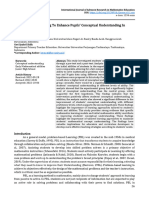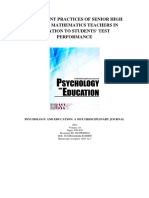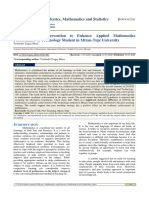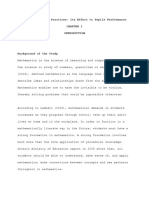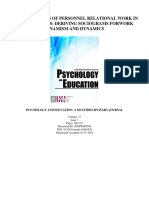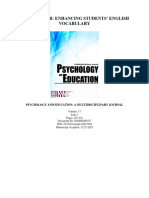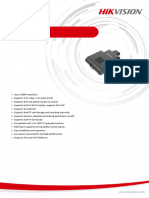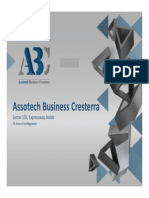Enhancing The Students' Mathematical Achievement Via Project ADFEISM
Enhancing The Students' Mathematical Achievement Via Project ADFEISM
Copyright:
Available Formats
Enhancing The Students' Mathematical Achievement Via Project ADFEISM
Enhancing The Students' Mathematical Achievement Via Project ADFEISM
Original Title
Copyright
Available Formats
Share this document
Did you find this document useful?
Is this content inappropriate?
Copyright:
Available Formats
Enhancing The Students' Mathematical Achievement Via Project ADFEISM
Enhancing The Students' Mathematical Achievement Via Project ADFEISM
Copyright:
Available Formats
ENHANCING THE STUDENTS’ MATHEMATICAL
ACHIEVEMENT VIA PROJECT ADFEISM
PSYCHOLOGY AND EDUCATION: A MULTIDISCIPLINARY JOURNAL
2023
Volume: 13
Pages: 454-458
Document ID: 2023PEMJ1176
DOI: 10.5281/zenodo.8341638
Manuscript Accepted: 2023-11-9
Psych Educ, 2023, 13: 454-458, Document ID:2023 PEMJ1176, doi:10.5281/zenodo.8341638, ISSN 2822-4353
Research Article
Enhancing the Students’ Mathematical Achievement Via Project ADFEISM
Rince Cheal A. Entice*, Mary Antoneth B. Gamayon, Jomar N. Apus
For affiliations and correspondence, see the last page.
Abstract
This study determined whether the implementation of project ADFEISM can enhance grade 9
students’ performance in learning quadratic equations. This study used a quasi-experimental design
with two intact classes of problematic sections. Both groups underwent the pretest before the lessons
on quadratic equations were introduced. The controlled group was exposed to the conventional
teaching method, while the experimental was exposed to teaching with the project ADFEISM with
the mastery learning approach. Based on the findings, it is proved that there is a significant difference
between the performance of the students in the control and experimental group towards learning
quadratic equation. This implies that teaching of Mathematics with a special emphasis of the basic
topics like what were included in the Project ADFEISM will help students enhance their mathematics
performance and make them more prepared to study advanced mathematical concepts.
Keywords: quasi-experimental, ADFEISM, learning quadratic equations, mastery learning approach,
mathematical concepts
Introduction effects create negative and positive outcomes. As a
developing country, the negative effects such as
unpreparedness in terms of gadgets, finances, and even
A solid mathematical foundation and the application of school equipment are so overwhelming. The changes
a mastery learning strategy have been identified as from formal face to face classes into modular-online
critical variables in increasing student mathematics approach is so hard to adapt, not just by the students
performance. This study aims to investigate the but especially by the teachers due to lack of trainings
relationship between a strong mathematical which lead to a low performance rate of teachers and
foundation, the mastery learning technique, and students during the first wave of the implementation of
students' mathematics performance, drawing on the new normal educational system in the country. On
relevant studies and research in the field. A good the opposite aspect, this pandemic serves as a blessing
mastery of essential mathematical concepts, principles, in disguise for it unleashes and awakens the bright and
and skills is referred to as having a firm mathematical innovative ideas of all the classroom teachers to create
foundation. Swanson et al. (2017) discovered that sublime and admirable strategies and interventions to
children with a strong mathematical background ensure that comprehensive teaching and learning
display better levels of mathematical competency and
experiences will still take place amidst this raging
problem-solving ability. This foundation serves as a
battle. Thus, as Mathematics classroom teachers of
scaffolding for additional mathematical learning,
San Francisco De Asis National High School, we have
allowing pupils to approach more complicated
initiated an innovation to address the learning gaps and
mathematical topics with confidence and ease.
make sure that concretized learning outcomes will still
Bloom's (1976) mastery learning model stresses be accomplished.
personalized training and mastery of learning
ADFEISM (Addition, Division, Decimals, Fraction,
objectives before proceeding to new information.
Factors, Exponents, Integers, Subtraction, Square
Students are given targeted feedback, further practice,
Roots, Multiplication and Multiples) in teaching
and opportunity for remediation in this technique until
they achieve mastery of the subject area. According to mathematics plays great role in developing and
Guskey and Pigott (2019), the mastery learning nurturing the mathematical capacity of every learner. It
strategy leads to considerable improvements in is a mnemonic of basic topics in mathematics which
mathematics performance because it allows students to reinforces the key foundational concepts that are
develop a deep comprehension of mathematical ideas critical for higher topics in mathematics. It is designed
and a solid knowledge base. for junior high school students who need support in
addition to their regular class instruction. Specifically,
The impact of the Covid-19 pandemic creates very it is developed to address students' needs with the
abrupt changes in all facets of the educational system, basics of numbers and operations, content is sequenced
not just in the Philippines but across all countries; its and paced to build understanding and skills.
Entice et al. 454/458
Psych Educ, 2023, 13: 454-458, Document ID:2023 PEMJ1176, doi:10.5281/zenodo.8341638, ISSN 2822-4353
Research Article
It is organized into 7 lessons that contains 2 meetings early mathematical education affected later academic
of 30-minute to 1-hour discussions that include step- success. Johnson and Williams (2018) delved into how
by-step teaching support, face to face instruction, peer a concentrated math curriculum in elementary schools
tutorial, video presentation, activity sheets and affected students' subsequent accomplishments.
embedded assessmen ts. The ADFEISM in According to the study, pupils who got intense
mathematics also employs Mastery Learning mathematics training in their early years performed
Approach where students are required to pass specific better on standardized examinations across the course
standards in every lesson. This assures the students’ of their academic careers in all subject areas. This
readiness in the next lesson. conclusion implies that a student's early exposure to
mathematics can act as a powerful predictor of future
Research Questions academic achievement.
This study determined whether the implementation of The literature also discusses how excellent teachers
project adfeism can enhance grade 9 students’ contribute to developing a solid mathematical
performance in learning quadratic equations. foundation. The academic accomplishment and
Specifically, this study answered the following mathematical performance of children were found to
questions: be positively improved by highly qualified and
experienced mathematics teachers in a study by Brown
1. What is the performance of the students in both and Robinson (2015). The study made a point of
control and experimental group before and after the highlighting the importance of good teaching
intervention? techniques, educational approaches, and learning
2. Is there a significant difference between the environments in encouraging mathematical
performance of the students in both control and engagement and learning. These results highlight the
experimental group before and after the intervention? value of teacher preparation programs and continued
3. Is there a significant difference between posttest professional development for raising the standard of
scores of the students across groups? math education.
In addition, studies have looked at how technological
Literature Review developments affect the formation of a solid
mathematical foundation. Wang and Chen (2020)
A solid mathematical foundation is essential for look ed into how ed ucat io n al tech n o lo gy
academic success and the development of critical resources—like interactive simulations and virtual
thinking skills. This review investigates the value of a manipulatives—affect students' academic achievement
solid mathematical foundation and the application of and mathematical knowledge. The research discovered
the mastery learning approach as a successful that include these digital tools in mathematics lessons
instructional strategy. The literature and studies improved students' conceptual comprehension,
considered in this review are within the last six years. problem-solving abilities, and general academic
performance. These findings highlight the potential of
Strong mathematical foundation on Academic technology as a supplement to conventional teaching
Performance strategies to enhance mathematical learning outcomes.
Several studies have stressed the importance of a solid Mastery learning approach as an effective
mathematical foundation in academic performance. instructional strategy
Smith et al. (2016), for instance conducted a
longitudinal study with a large sample of high school Hattie, Fisher, and Frey's (2017) study demonstrates
students and discovered that students with advanced the advantages of a mastery learning method in
mathematical skills performed better in science and mathematics instruction. Before moving on to more
technology topics than their classmates with poorer complicated subjects, mastery learning emphasizes
mathematical ability. Furthermore, the study getting students a firm grasp of basic mathematical
demonstrated the positive association between ideas. It enables tailored feedback and training, as well
mathematical competency and critical thinking skills, as the chance for students to learn each idea at their
revealing the larger implications of mathematical own rate. These conclusions are supported by a study
competence on overall academic success. by Son (2016), which shows that students who learned
through a mastery learning strategy attained higher
Another group of studies looked specifically at how levels of mathematics understanding and outperformed
Entice et al. 455/458
Psych Educ, 2023, 13: 454-458, Document ID:2023 PEMJ1176, doi:10.5281/zenodo.8341638, ISSN 2822-4353
Research Article
peers in conventional educational settings on ability, closes achievement disparities, and strengthens
assessments. metacognitive skills. This strategy's use can
considerably improve kids' academic progress,
Furthermore, it has been demonstrated that developing cognitive growth, and knowledge of mathematics.
a solid mathematical foundation using the mastery
learning approach improves problem-solving abilities.
According to a 2017 study by Williams and Salgado, Methodology
students who participated in mastery learning showed
enhanced problem-solving skills and a higher degree
Sampling Method
of mathematical thinking. In a similar vein, Kim and
Lee's (2018) study discovered that students who were The participants of this study were the two (2) intact
taught utilizing the mastery learning approach had sections of grade 9. They were purposively chosen
improved problem-solving strategies, including since were found to be problematic in the said subject.
systematic analysis of problems, finding pertinent Section A is composed of thirty (30) students which
material, and applying appropriate mathematical comprised the controlled group while Section B is
procedures. composed of thirty-two (32) students which comprised
the experimental group.
A solid mathematical foundation and the mastery
learning technique have benefits outside of the Research Design
classroom in addition to academic success. According
to a study by Huang and Leung (2016), students who This study used quasi-experimental design with two
received mastery learning training expressed stronger intact classes of problematic sections. Both groups
levels of mathematical confidence and a greater underwent the pretest before the lessons on quadratic
enthusiasm in pursuing professions in the field. This equation were introduced. The controlled group was
research implies that students' attitudes and aspirations exposed to the conventional teaching method while the
toward mathematics and related subjects might be experimental was exposed to teaching with the project
favorably influenced by a solid mathematical ADFEISM with mastery learning approach.
foundation.
Statistical Treatment
In order to bridge achievement disparities, the mastery
learning approach has also been recognized as a In treating the data, statistical tools were used by the
successful strategy. The advantages of mastery researcher. For data in Problem 1, descriptive statistics
learning in narrowing achievement gaps across such are mean and standard deviation were used since
students from various socioeconomic backgrounds are the researcher wants to find out the average scores and
highlighted according to research by Cheung and its distance from the mean. Problem 2, the paired
Slavin (2016). Mastery learning's customized nature sample t-test is used to determine if there is a
enables focused support and interventions that aid significant difference between the scores of the
students in overcoming learning obstacles and students, both control and experimental, in the pretest
enhancing their mathematics ability.Research further and posttest. For Problem 3, the independent sample t-
supports the notion that mastery learning and a solid test is used to determine if there is a significant
mathematical foundation are directly related to higher- difference between the performance of the students
order thinking skills and metacognitive capacities. across groups in their posttest. All the tests used
Kaur and Widjaja's (2017) research contend that α=0.05 level of significance.
m astery learn ing p romo tes the growth of
metacognitive skills like self-control and learning Research Instrument
progress monitoring. To become independent learners
and engage in more complex mathematical thought, The research instrument used to gather the data and
students must develop these metacognitive skills. information of this study were the DepEd-made pre-
test and post-test questionnaires. The test consisted of
The reviewed literature and studies emphasize the 50 items multiple choices from the validated DepEd
value of a solid mathematical foundation and the modules that covered the Quadratic Equation.
effectiveness of the mastery learning approach in Students were given 1 hour and 30 minutes to answer
mathematics education, which brings us to our and finish the test. Pre-test was given before the
conclusion. The mastery learning approach facilitates intervention proper while the post-test was
individualized education, develops problem-solving administered after the intervention. There was no need
Entice et al. 456/458
Psych Educ, 2023, 13: 454-458, Document ID:2023 PEMJ1176, doi:10.5281/zenodo.8341638, ISSN 2822-4353
Research Article
controlled group. As shown in the table, the
to conduct test validation, reliability test and pilot probability value is 0.00 which is lower than the alpha
testing since DepEd modules were properly screened, value of 0.05. This implied that there was strong
checked and validated by the experts in the evidence to reject the null hypothesis and to accept the
Department of Education. alternative hypothesis. This means that the
performance of the students who were exposed to
conventional method was significantly higher during
Results and Discussion the post-test as compared to their performance during
the pre-test.
Table 1. Performance of the students in both control Table 4. Significant difference between the
and experimental group before the intervention performance of the students in experimental group
before and after the intervention
Table 1 shows the distribution of the test scores of the
students in both controlled and experimental groups in
the pretest on quadratic equation. The data showed that
students in both groups have more or less the same
performance in the pretest as shown in their mean Table 4 presents the significant difference in the pre-
scores categorized as failed or needs improvement. test and post-test mean scores of students in the
experimental group. As shown in the table, the
Table 2. Performance of the students in both control probability value is 0.00 which is lower than the alpha
and experimental group after the intervention value of 0.05. This implied that there was strong
evidence to reject the null hypothesis and to accept the
alternative hypothesis. This means that the
performance of the students who were exposed to
project ADFEISM was significantly higher during the
post-test as compared to their performance during the
Table 2 presents the distribution of the test scores of pre-test.
the students in both controlled and experimental
groups in the posttest on quadratic equation. The data Table 5. Testing of significant difference between the
showed a positive change in the mean scores of the posttest scores of the students across groups
students for both groups which is a clear indication of
an increase in performance during the posttest. Despite
of the observable difference of the two groups on their
posttest scores, still both controlled and experimental
group are categorized as very satisfactory.
Table 5 shows the independent sample t-test of the
Table 3. Significant difference between the students’ performance in the posttest across the two
performance of the students in controlled group before groups. Note that the p-value is lower than 0.05 which
and after the intervention means that the difference is significant. This means
that students in the experimental group gained more
and better understanding in learning quadratic equation
through the project ADFEISMN intervention than
those of the students who underwent conventional
teaching.
Table 3 presents the significant difference in the pre-
test and post-test mean scores of students in the This finding conforms to the findings of Johnson and
Williams (2018) investigated the effects of a focused
mathematical curriculum in elementary schools and its
Entice et al. 457/458
Psych Educ, 2023, 13: 454-458, Document ID:2023 PEMJ1176, doi:10.5281/zenodo.8341638, ISSN 2822-4353
Research Article
influence on students' future achievements. The study Guskey, T. R., & Pigott, T. D. (2019). The handbook of mastery
learning. SAGE Publications
revealed that students who received intensive
mathematical instruction in their early years Hattie, J., Fisher, D., & Frey, N. (2017). Visible learning for
demonstrated higher scores in standardized tests across mathematics, grades K-12: What works best to optimize student
multiple subjects throughout their academic journey. learning. Corwin.
Additionally, Brown and Robinson (2015) discovered Huang, R., & Leung, A. (2016). Effects of mastery learning
that highly skilled and experienced mathematics approach on students' mathematics achievement and attitudes
teachers had a beneficial impact on students' academic towards mathematics: A meta-analysis. Educational Psychology
Review, 28(4), 797-829. DOI: 10.1007/s10648-015-9325-4
success and mathematical proficiency. The study
highlighted the significance of effective teaching Johnson, J., & Williams, K. (2018). Early mathematical education
strategies, instructional methods, and classroom and subsequent academic achievement: A systematic review.
environments in promoting mathematical engagement Educational Psychology Review, 30(3), 685-712. DOI:
10.1007/s10648-017-9400-3
and learning. These findings underscore the
importance of teacher training and ongoing Kaur, B., & Widjaja, W. (2017). Effects of a mastery learning
professional development to improve the quality of approach on mathematics performance
mathematical education. Kim, Y., & Lee, J. (2018). Enhancing mathematical problem solving
through mastery learning: Effects on mathematical problem-solving
strategies and mathematics self-efficacy. Journal of Educational
Conclusion Computing Research, 5 6 (7 ) , 1043-1069. DOI:
1 0 .11 77 /0 73 563 31 17 719 01 3
Based on the findings, it is proved that there is a Smith, R., Jones, T., & Johnson, L. (2016). The relationship between
mathematical proficiency and academic achievement in science and
significant difference between the performance of the technology subjects. Journal of Educational Research, 109(4),
students in the control and experimental group towards 453-465. DOI: 10.1080/00220671.2014.994063
learning quadratic equation. This implies that teaching
Son, J. (2016). The effect of a mastery learning approach on
of Mathematics with a special emphasis of the basic
mathematical achievement: A meta-analysis. Studies in Educational
topics like what were included in the Project Evaluation, 49, 1-10. DOI: 10.1016/j.stueduc.2015.12.002
ADFEISM will help students enhance their
mathematics performance and make them more Swanson, H. L., Eberhardt, M. A., & Serlin, R. C. (2017). Does
mathematics intervention improve mathematics achievement?
prepared to study advanced mathematical concepts. It Results from a randomized control trial. Journal of Educational
is also shown that applying mastery learning approach Psychology, 109(7), 983-1002. DOI: 10.1037/edu0000169
helps students learn efficiently and effectively in the
Wang, L., & Chen, D. (2020). The impact of educational technology
mathematics subject. It is recommended that the
on students' mathematical understanding: A meta-analysis.
implementation of project ADFEISM be incorporated C o m p u t e r s & E d u c a t i o n , 1 5 0 , 1 0 3 8 3 9 . D O I:
in teaching Mathematics. The Department of 1 0 .10 16 /j . co m pe du .2 02 0. 10 383 9
Education should find ways to integrate specific time
Williams, K. C., & Salgado, C. L. (2017). Investigating the effect of
slots for this crucial intervention.Furthermore, it is also mastery learning on students' mathematical problem-solving
recommended to conduct more studies about the abilities. Journal of Education and Learning
implementation of project ADFEISM in teaching not
just Mathematics in order to thoroughly verify its Affiliations and Corresponding Information
efficacy, into several other areas. Rince Cheal A. Entice, MAEd
El Salvador City National High School
References Department of Education – Philippines
Mary Antoneth B. Gamayon
Bloom, B. S. (1976). Mastery learning: Theory and practice. Holt, Himaya National High School
Rinehart, and Winston. Department of Education – Philippijnes
Brown, S., & Robinson, C. (2015). The role of the mathematics Jomar N. Apus
teacher in developing students' mathematical promise. Mathematics San Francisco National High School
Education Research Journa l, 27(3), 267 -289. DOI:
Department of Education – Philippines
10.1007/s13394-015-0147-9
Cheung, A. C., & Slavin, R. E. (2016). How features of educational
technology applications affect student reading outcomes: A meta-
analysis. Educational Research Review, 18, 88-113. DOI:
10.1016/j.edurev.2016.02.001
Entice et al. 458/458
You might also like
- Effectiveness of Project Bilang Ka in Increasing The Mathematical Performance of Grade 3 Pupils in Pambuhan Elementary SchoolDocument7 pagesEffectiveness of Project Bilang Ka in Increasing The Mathematical Performance of Grade 3 Pupils in Pambuhan Elementary SchoolPsychology and Education: A Multidisciplinary JournalNo ratings yet
- Implementation of Project Numero at Cresdaville Elementary School: An ExplorationDocument7 pagesImplementation of Project Numero at Cresdaville Elementary School: An ExplorationPsychology and Education: A Multidisciplinary JournalNo ratings yet
- Attitudes and Academic Performance of Grade 6 Students in Learning Mathematics: Conceptual Understanding in The Context of EducationDocument10 pagesAttitudes and Academic Performance of Grade 6 Students in Learning Mathematics: Conceptual Understanding in The Context of EducationPsychology and Education: A Multidisciplinary JournalNo ratings yet
- Project Pagbasa Kag Pagsuma (3Ps) : Bridging The Learning Gaps of Grade 7 Students in Numeracy LevelsDocument7 pagesProject Pagbasa Kag Pagsuma (3Ps) : Bridging The Learning Gaps of Grade 7 Students in Numeracy LevelsPsychology and Education: A Multidisciplinary JournalNo ratings yet
- Ijimsep S 4 2020Document7 pagesIjimsep S 4 2020ajamueniola3No ratings yet
- Grade 9 Learners' Engagement and Performance in Flipped Mathematics ClassroomDocument12 pagesGrade 9 Learners' Engagement and Performance in Flipped Mathematics ClassroomPsychology and Education: A Multidisciplinary JournalNo ratings yet
- Utilization of Math USAD (Umpisahan Sa Addition Hanggang Division) and Its Effects On Mathematical Performance of Grade 7 Students: An Action ResearchDocument7 pagesUtilization of Math USAD (Umpisahan Sa Addition Hanggang Division) and Its Effects On Mathematical Performance of Grade 7 Students: An Action ResearchPsychology and Education: A Multidisciplinary JournalNo ratings yet
- Chapter 1-4Document32 pagesChapter 1-4Arturo MortelNo ratings yet
- Research Proposal 2.0Document11 pagesResearch Proposal 2.0Ivan MolinaNo ratings yet
- Brenda Inlammong Proposal As-Of-June-2523Document39 pagesBrenda Inlammong Proposal As-Of-June-2523Brenda PugongNo ratings yet
- The Effects of Direct and Indirect Instruction On Students Achievements in MathematicsDocument18 pagesThe Effects of Direct and Indirect Instruction On Students Achievements in MathematicsCristie MarcelinoNo ratings yet
- Project WERPA (Worksheets, E - E-Games, Remediation & Peer AssistanceDocument8 pagesProject WERPA (Worksheets, E - E-Games, Remediation & Peer AssistanceIOER International Multidisciplinary Research Journal ( IIMRJ)No ratings yet
- Improving First-Year Pre-Service Teacher's Concept of Fractions Using "Cuisenaire Rods"Document23 pagesImproving First-Year Pre-Service Teacher's Concept of Fractions Using "Cuisenaire Rods"International Journal of Innovative Science and Research TechnologyNo ratings yet
- Effectsof Four Teaching Strategiesonthe Academic Performanceof Senior High School StudentsDocument9 pagesEffectsof Four Teaching Strategiesonthe Academic Performanceof Senior High School StudentsboolnivaNo ratings yet
- Reymond G. Tugadi For Journal-To PassDocument7 pagesReymond G. Tugadi For Journal-To PassJohn Lloyd D. CatubigNo ratings yet
- Action Research - Play Based Learning As A Meato ResolveDocument16 pagesAction Research - Play Based Learning As A Meato ResolveReunion MabasaNo ratings yet
- Constructivist ApproachDocument10 pagesConstructivist Approach523000010No ratings yet
- 1 Chapter 1Document21 pages1 Chapter 1Christian Paul DiazNo ratings yet
- Utilization of Knowledge Channel Educational Package in Teaching Mathematics For Grade Five Pupils in Pulong Kumanoy Elementary SchoolDocument7 pagesUtilization of Knowledge Channel Educational Package in Teaching Mathematics For Grade Five Pupils in Pulong Kumanoy Elementary SchoolPsychology and Education: A Multidisciplinary JournalNo ratings yet
- J1 Pentaksiran Terbeza Contoh RujukanDocument35 pagesJ1 Pentaksiran Terbeza Contoh RujukanMASLINDA BINTI YAHAYA MoeNo ratings yet
- IntroductionDocument8 pagesIntroductionmaharlikaqwertyNo ratings yet
- 383 - ICTIEE2024 - JEET - Paper - ID - 383 - Vijayalakshmi RamasamyDocument9 pages383 - ICTIEE2024 - JEET - Paper - ID - 383 - Vijayalakshmi RamasamylouiejohnpandiliNo ratings yet
- 3.+arikel+3Document10 pages3.+arikel+3Maniru Aliyu GiganeNo ratings yet
- Article 3244Document11 pagesArticle 3244jnrockerzNo ratings yet
- Blended Learning Pillars and Senior High School Performance in Statistics Hypothesis Testing Towards Mathematics WorksheetsDocument8 pagesBlended Learning Pillars and Senior High School Performance in Statistics Hypothesis Testing Towards Mathematics WorksheetsioerimrjNo ratings yet
- Assessment Practices of Senior High School Mathematics Teachers in Relation To Students' Test PerformanceDocument12 pagesAssessment Practices of Senior High School Mathematics Teachers in Relation To Students' Test PerformancePsychology and Education: A Multidisciplinary JournalNo ratings yet
- Career Aspirations of Stem Students of University of Batangas TowardsDocument5 pagesCareer Aspirations of Stem Students of University of Batangas TowardsWatty UserNo ratings yet
- Efficacy of Learning Modules in CalculusDocument49 pagesEfficacy of Learning Modules in CalculusJenefer BendejoNo ratings yet
- SJPMS 73 34-39Document6 pagesSJPMS 73 34-39xfbefdvdvaNo ratings yet
- FINAL-MAED-MAAM-SHEINA-Produced FinalDocument41 pagesFINAL-MAED-MAAM-SHEINA-Produced FinalSheina AnocNo ratings yet
- MathDocument9 pagesMathCris DahunanNo ratings yet
- Research Carmonacantera FinalDocument84 pagesResearch Carmonacantera FinalMONIC STRAISAND DIPARINENo ratings yet
- Assessment of Teachers' Performance and The Spiral Progression Approach in MathematicsDocument8 pagesAssessment of Teachers' Performance and The Spiral Progression Approach in MathematicsInternational Journal of Innovative Science and Research TechnologyNo ratings yet
- Utilization of Project - Based Learning (PBL) Resources in Senior High SchoolDocument8 pagesUtilization of Project - Based Learning (PBL) Resources in Senior High SchoolIOER International Multidisciplinary Research Journal ( IIMRJ)No ratings yet
- Chapter 1 EditedDocument12 pagesChapter 1 EditedRamey OtuanNo ratings yet
- Ijisrt PaglinawanDocument9 pagesIjisrt Paglinawanghost.aleqNo ratings yet
- IMRAD Anonuevo Culla EngayDocument8 pagesIMRAD Anonuevo Culla EngayicamaecullaNo ratings yet
- Lezilda S. SisonDocument9 pagesLezilda S. SisontontohamidaNo ratings yet
- @ Action Research, To Be CheckDocument24 pages@ Action Research, To Be Checklazagajulieanne27No ratings yet
- Metacognitive Awareness As A Predictor of Mathematical Modeling Competency Among Preservice Elementary TeachersDocument14 pagesMetacognitive Awareness As A Predictor of Mathematical Modeling Competency Among Preservice Elementary Teachersjupeth pentangNo ratings yet
- Chapter 1 (Old)Document12 pagesChapter 1 (Old)Nicolai FabillarNo ratings yet
- Micro Learning-Based Module: A Teaching Tool To Enhance Students' Competence in Grade 9 TrigonometryDocument8 pagesMicro Learning-Based Module: A Teaching Tool To Enhance Students' Competence in Grade 9 TrigonometryInternational Journal of Innovative Science and Research TechnologyNo ratings yet
- The Effectiveness of Differentiated Instruction in Improving Math Achievement For Students With Diverse Learning NeedsDocument4 pagesThe Effectiveness of Differentiated Instruction in Improving Math Achievement For Students With Diverse Learning NeedsInternational Journal of Innovative Science and Research TechnologyNo ratings yet
- My Project . .Chapter OneDocument47 pagesMy Project . .Chapter OneOluwatobilobaNo ratings yet
- Action Research by Earl Abad For Online Submission WordDocument32 pagesAction Research by Earl Abad For Online Submission WordNoraysa BatawanNo ratings yet
- Rey Ensepedo Thesis For CheckingDocument24 pagesRey Ensepedo Thesis For CheckingRey EnsepedoNo ratings yet
- Research - Chapter 1-2Document20 pagesResearch - Chapter 1-2junhetylionaceavilaNo ratings yet
- Critique Paper On Instructional DesignDocument9 pagesCritique Paper On Instructional Designdinnes masubayNo ratings yet
- Inbound 909056306377332284Document11 pagesInbound 909056306377332284Bryan Emberga AbelardeNo ratings yet
- Research Paper 2Document24 pagesResearch Paper 2Mark Lacaste De GuzmanNo ratings yet
- Benefits of Peer Tutoring in Enhancing Students'Document12 pagesBenefits of Peer Tutoring in Enhancing Students'marvin pulaoNo ratings yet
- Students' Learning Styles and Performance in Mathematics Basis For The Development of Teaching MaterialsDocument12 pagesStudents' Learning Styles and Performance in Mathematics Basis For The Development of Teaching MaterialsInternational Journal of Innovative Science and Research TechnologyNo ratings yet
- Group3 Chapter 1 3 BSED MATH 3 1Document25 pagesGroup3 Chapter 1 3 BSED MATH 3 1Toreno JamesNo ratings yet
- Chapter-1 RevisedDocument15 pagesChapter-1 Revisedsymendoza088No ratings yet
- 5051 Ijrse FinalDocument13 pages5051 Ijrse FinaltontohamidaNo ratings yet
- Action Research Team TeachingDocument21 pagesAction Research Team Teachingrosemalyn pahamtangNo ratings yet
- Cabellon CbarDocument21 pagesCabellon CbarAdi CabellonNo ratings yet
- Inbound 226804639302058231Document13 pagesInbound 226804639302058231nashleyreyes1006No ratings yet
- Learning Strategies of Grade 12 Students of Data Center College of The Philippines Academic Achievers in Studying MathematicsDocument11 pagesLearning Strategies of Grade 12 Students of Data Center College of The Philippines Academic Achievers in Studying Mathematicscyantagapong143No ratings yet
- Teaching Mathematics in the Middle School Classroom: Strategies That WorkFrom EverandTeaching Mathematics in the Middle School Classroom: Strategies That WorkNo ratings yet
- Psychology and Education: A Multidisciplinary JournalDocument11 pagesPsychology and Education: A Multidisciplinary JournalPsychology and Education: A Multidisciplinary JournalNo ratings yet
- Self-Concept and Level of Career Interest of Grade 9 Students at San Roque National High SchoolDocument10 pagesSelf-Concept and Level of Career Interest of Grade 9 Students at San Roque National High SchoolPsychology and Education: A Multidisciplinary JournalNo ratings yet
- Leadership Style of The School Heads As Correlates To The Level of Efficiency of Management Practices: Inputs For Professional Development PlanDocument15 pagesLeadership Style of The School Heads As Correlates To The Level of Efficiency of Management Practices: Inputs For Professional Development PlanPsychology and Education: A Multidisciplinary Journal100% (1)
- Post-Pandemic Performance in Content Mastery and Cognitive Skills of Junior High School Students in ChemistryDocument7 pagesPost-Pandemic Performance in Content Mastery and Cognitive Skills of Junior High School Students in ChemistryPsychology and Education: A Multidisciplinary JournalNo ratings yet
- Improving Mastery Level in Understanding Typhoon and Earthquake Preparedness Through STEM ModulesDocument12 pagesImproving Mastery Level in Understanding Typhoon and Earthquake Preparedness Through STEM ModulesPsychology and Education: A Multidisciplinary JournalNo ratings yet
- Unlocking Opportunities: The Key To Successful Destigmatization of Ex-OffendersDocument11 pagesUnlocking Opportunities: The Key To Successful Destigmatization of Ex-OffendersPsychology and Education: A Multidisciplinary JournalNo ratings yet
- Four Dimensions of Personnel Relational Work in Multi-Settings: Deriving Sociograms For Work Dynamism and DynamicsDocument17 pagesFour Dimensions of Personnel Relational Work in Multi-Settings: Deriving Sociograms For Work Dynamism and DynamicsPsychology and Education: A Multidisciplinary JournalNo ratings yet
- Influence of Teacher's Personality and Behavior On Students Character BuildingDocument8 pagesInfluence of Teacher's Personality and Behavior On Students Character BuildingPsychology and Education: A Multidisciplinary JournalNo ratings yet
- Phonological Awareness of Kindergarten TeachersDocument14 pagesPhonological Awareness of Kindergarten TeachersPsychology and Education: A Multidisciplinary Journal100% (1)
- Pet Loss: A Study On The Relationship Between Attachment Styles and Cognitive-Emotion Regulation Strategy Among Elderly Pet Owners in Quezon CityDocument12 pagesPet Loss: A Study On The Relationship Between Attachment Styles and Cognitive-Emotion Regulation Strategy Among Elderly Pet Owners in Quezon CityPsychology and Education: A Multidisciplinary JournalNo ratings yet
- The Level of Learners' Performance in Mathematics Through Mind Mapping StrategyDocument9 pagesThe Level of Learners' Performance in Mathematics Through Mind Mapping StrategyPsychology and Education: A Multidisciplinary JournalNo ratings yet
- The Influence of Digital Marketing Strategies On Customer's Purchase Intention of Selected Fast-Food RestaurantsDocument14 pagesThe Influence of Digital Marketing Strategies On Customer's Purchase Intention of Selected Fast-Food RestaurantsPsychology and Education: A Multidisciplinary JournalNo ratings yet
- Game-Based and Project-Based Approaches: Their Effects On Grade 10 Learners' Performance in BiologyDocument9 pagesGame-Based and Project-Based Approaches: Their Effects On Grade 10 Learners' Performance in BiologyPsychology and Education: A Multidisciplinary JournalNo ratings yet
- Digital Orientation and Cyber-Victimization of College Students As Mediated by Their Attitude Toward CrimeDocument12 pagesDigital Orientation and Cyber-Victimization of College Students As Mediated by Their Attitude Toward CrimePsychology and Education: A Multidisciplinary JournalNo ratings yet
- Exploring Factors Influencing The Non-Completion of Theses Among Teachers Pursuing A Master's Degree: A Case Study AnalysisDocument10 pagesExploring Factors Influencing The Non-Completion of Theses Among Teachers Pursuing A Master's Degree: A Case Study AnalysisPsychology and Education: A Multidisciplinary JournalNo ratings yet
- Empowerment, Organizational Commitment, and Management Performance of Secondary School Heads in The New Normal in The Division of PalawanDocument16 pagesEmpowerment, Organizational Commitment, and Management Performance of Secondary School Heads in The New Normal in The Division of PalawanPsychology and Education: A Multidisciplinary JournalNo ratings yet
- Love Corner: Enhancing Students' English VocabularyDocument10 pagesLove Corner: Enhancing Students' English VocabularyPsychology and Education: A Multidisciplinary JournalNo ratings yet
- The Experiences of The Lebakeño Grade XI Students On Learning Mathematics in The Modular Approach: Basis For Learning FrameworkDocument34 pagesThe Experiences of The Lebakeño Grade XI Students On Learning Mathematics in The Modular Approach: Basis For Learning FrameworkPsychology and Education: A Multidisciplinary JournalNo ratings yet
- Classroom Management Practices of Teachers and Academic Performance of Grade 3 Learners Across All Learning AreasDocument10 pagesClassroom Management Practices of Teachers and Academic Performance of Grade 3 Learners Across All Learning AreasPsychology and Education: A Multidisciplinary JournalNo ratings yet
- Watching Movies With English Subtitles and Vocabulary Performance of SPA LearnersDocument12 pagesWatching Movies With English Subtitles and Vocabulary Performance of SPA LearnersPsychology and Education: A Multidisciplinary JournalNo ratings yet
- Vocabulary Development and Comprehension Skills Through Word Games Among Grade 4 LearnersDocument11 pagesVocabulary Development and Comprehension Skills Through Word Games Among Grade 4 LearnersPsychology and Education: A Multidisciplinary JournalNo ratings yet
- Effectiveness of Gamification Strategy in Increasing The Grade 10 Student's Academic MotivationDocument9 pagesEffectiveness of Gamification Strategy in Increasing The Grade 10 Student's Academic MotivationPsychology and Education: A Multidisciplinary JournalNo ratings yet
- Multimedia Approach in Teaching Science Grade 7Document10 pagesMultimedia Approach in Teaching Science Grade 7Psychology and Education: A Multidisciplinary JournalNo ratings yet
- SQP2RS Strategy in Teaching Reading Using Different Text Types Among Grade 9 Learners: An Experimental InquiryDocument13 pagesSQP2RS Strategy in Teaching Reading Using Different Text Types Among Grade 9 Learners: An Experimental InquiryPsychology and Education: A Multidisciplinary JournalNo ratings yet
- Grade 11 ICT Students' Mastery Level in Setting Up Computer Networks Instructed Using CSS DroidDocument5 pagesGrade 11 ICT Students' Mastery Level in Setting Up Computer Networks Instructed Using CSS DroidPsychology and Education: A Multidisciplinary JournalNo ratings yet
- Effect of T Math Modules To The Numeracy Level of Grade 6 Learners of Patabog Elementary SchoolDocument12 pagesEffect of T Math Modules To The Numeracy Level of Grade 6 Learners of Patabog Elementary SchoolPsychology and Education: A Multidisciplinary JournalNo ratings yet
- Career Pathways of Technical, Vocational and Livelihood Senior High School Graduates in Pililla National High SchoolDocument10 pagesCareer Pathways of Technical, Vocational and Livelihood Senior High School Graduates in Pililla National High SchoolPsychology and Education: A Multidisciplinary Journal100% (1)
- Relationship Between Attitudes of College Students Toward Statistics and Research CoursesDocument8 pagesRelationship Between Attitudes of College Students Toward Statistics and Research CoursesPsychology and Education: A Multidisciplinary JournalNo ratings yet
- Impact of Mental Health Literacy On Attitude Toward Seeking Counseling Among Senior High School Students of Dr. Carlos S. Lanting CollegeDocument9 pagesImpact of Mental Health Literacy On Attitude Toward Seeking Counseling Among Senior High School Students of Dr. Carlos S. Lanting CollegePsychology and Education: A Multidisciplinary JournalNo ratings yet
- Information and Communication Technology (ICT) Skills Among Teachers in The Division of Lanao Del NorteDocument14 pagesInformation and Communication Technology (ICT) Skills Among Teachers in The Division of Lanao Del NortePsychology and Education: A Multidisciplinary JournalNo ratings yet
- Clinitek Advantus SpecifDocument2 pagesClinitek Advantus SpecifmediscitecNo ratings yet
- Gran Poder en InglesDocument12 pagesGran Poder en InglesCristhian FernandezNo ratings yet
- Applied For:: Objec VeDocument3 pagesApplied For:: Objec VeabiazizNo ratings yet
- Lesson Plan in MAPEH 3 - 2nd Week 5Document3 pagesLesson Plan in MAPEH 3 - 2nd Week 5DAHFNIE MACALANNo ratings yet
- WWW - Upjob, In: General Studies - Ii (Csat)Document25 pagesWWW - Upjob, In: General Studies - Ii (Csat)Sachin KulshreshthaNo ratings yet
- pl888226 Tod Inventory CutoffDocument21 pagespl888226 Tod Inventory Cutoffeltoquek0No ratings yet
- Full Download Mathematical Logic Through Python Yannai A. Gonczarowski PDFDocument84 pagesFull Download Mathematical Logic Through Python Yannai A. Gonczarowski PDFyezdanyacas100% (4)
- Basic Concepts in Relativity and Early Quantum Theory - Resnick & HallidayDocument353 pagesBasic Concepts in Relativity and Early Quantum Theory - Resnick & HallidayFernando Espinosa100% (1)
- Disabled Justice - Access To Justice and The UN Convention On The Rights of Persons With DisabilitiesDocument190 pagesDisabled Justice - Access To Justice and The UN Convention On The Rights of Persons With DisabilitiesSmita PandeyNo ratings yet
- Design of 6 Storey Building in EtabsDocument51 pagesDesign of 6 Storey Building in EtabsMisqal A Iqbal100% (2)
- SilverLinings PlaybookDocument3 pagesSilverLinings Playbookvadrarajal9No ratings yet
- Processing of Aerospace Materials - I (ME772) : Fracture Toughness and High Cycle Fatigue Date: 11 January 2022Document23 pagesProcessing of Aerospace Materials - I (ME772) : Fracture Toughness and High Cycle Fatigue Date: 11 January 2022B RITHIKANo ratings yet
- AE-DI2032-G40 20230615 PDFDocument7 pagesAE-DI2032-G40 20230615 PDFromelNo ratings yet
- AMR Practice MCQs 1Document13 pagesAMR Practice MCQs 1Ritchie ChathanatNo ratings yet
- CH 3 Part1collection and Distribution of WaterDocument78 pagesCH 3 Part1collection and Distribution of WaterMikiyas AkliluNo ratings yet
- Tourist Satisfaction An Analysis of Cultural Heritage in Miagao IloiloDocument11 pagesTourist Satisfaction An Analysis of Cultural Heritage in Miagao IloiloPhilip John SegundinoNo ratings yet
- Colors in FrenchDocument1 pageColors in FrenchCelia PageNo ratings yet
- Forgings NDE Guide PDFDocument26 pagesForgings NDE Guide PDFSathia Seelan100% (1)
- SQL Server2008 DBADocument263 pagesSQL Server2008 DBAStelian CorbutNo ratings yet
- Revised IPP Fin 2135 - Applied Management Science (2019-2020)Document16 pagesRevised IPP Fin 2135 - Applied Management Science (2019-2020)Jr CañeteNo ratings yet
- Benjamin's Age of Mechanical Reproduction by Richard KazisDocument13 pagesBenjamin's Age of Mechanical Reproduction by Richard KazisNadia QadirNo ratings yet
- Revision Booklet SOLUTIONDocument11 pagesRevision Booklet SOLUTIONFatima Al NeyadiNo ratings yet
- Seminar Project Report ON Trends in Automobile IndustryDocument28 pagesSeminar Project Report ON Trends in Automobile Industrygsrawat123No ratings yet
- Galvalume Fact Sheet-1Document1 pageGalvalume Fact Sheet-1Ewo50 NewNo ratings yet
- Assotech Business CresterraDocument33 pagesAssotech Business CresterraSultan KhanNo ratings yet
- Linguistics - Unit 2Document11 pagesLinguistics - Unit 2Appas Saha100% (1)
- Chloramphenicol, Cong ThudDocument2 pagesChloramphenicol, Cong ThudTri Nguyen NgocNo ratings yet
- The Art of Cold Emailing 1617646325Document26 pagesThe Art of Cold Emailing 1617646325Amit KhuranaNo ratings yet
- MOS Assignment 3Document11 pagesMOS Assignment 3Ritika MangalNo ratings yet
- Diagnostics and Measurements PDFDocument64 pagesDiagnostics and Measurements PDFMartin NilssonNo ratings yet






















